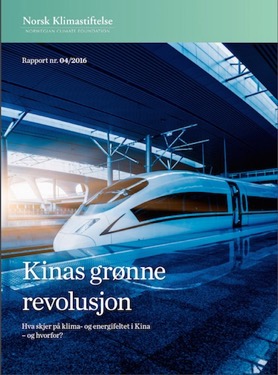The Tibetan plateau is the Earth´s largest store of ice after the two poles. Dramatic changes in the Third Pole have aroused general concern, Linling Chen writes in a new Norwegian report on China and the green revolution.
BY GUDRUN SYLTE, BJERKNES CENTRE FOR CLIMATE RESEARCH 09.06.2016
By Linling Chen, Nansen Environmental and Remote Sensing Centre/ Bjerknes Centre for Climate Research. published by the Norwegian Climate Foundation in a Norwegian report on the green revolution in China Kinas grønne revolusjon.
Just before the climate change negotiations in Paris, the Chinese government released its third scientific assessment report on how global warming affects China. The 900-page report contains contributions from more than 500 scientists and experts. It describes how China has been and will be affected by global warming from environmental, political and economical perspective. In this article, I will focus on the environmental aspect.
The report is available in Norwegian
Even though the assessment report is so far in Chinese only, the main findings of the report have been published in English by several newspapers, public offices etc., and can be summarized as follows:
- Average temperature across China has been rising faster than the global average (it rose between 0.9 and 1.5°C during 1909-2011). The regional warming will intensify, and the temperatures are projected to rise 1.3 – 5°C in most areas of China by the end of this century.
- The rate of sea level rise along China’s coasts (2.9 mm per year, 1980 – 2012) is higher than the global average.
- The glaciers in China have retreated dramatically since 1970s. The areas of glaciers and frozen ground have shrunk 10% and 18%, respectively.
- The rain pattern shift under global warming will continue.
How to understand these changes, and to what extent these changes have affected or are likely to affect China? In the following, I’ll discuss a topic that you may not familiar with, but is crucial to understand the observed climate change and its impact.
The third Pole
The Tibetan plateau, which is often called the Third Pole, is the highest plateau in the world (average height of 4 kilometers above sea level). The altitude makes it much colder than elsewhere outside of the Arctic and Antarctic. Thus, it’s easy to understand that it is the Earth’s largest store of ice after the two poles.
The topography of the plateau affects how winds circulate above it, and its altitude also places its surface into the middle of the troposphere, where most weather events originate. Therefore, the thermal and dynamical roles of the Tibetan plateau are crucial in our climate system. However, the Third Pole gets relatively less attention compared to the Arctic and Antarctic.
Observed changes and the influence
Given the fact of strong global warming in recent decades, the dramatic changes in the Third Pole have aroused general concern. In contrast to the slowing down warming trend in the rest of China and the global warming hiatus post-1990s, an accelerated (0.25 °C per decade) warming trend has been observed over the Tibetan Plateau during 1998–2013 (Duan and Xiao, 2015). The majority of glaciers on the plateau and in the surrounding region are retreating rapidly (Yao et al., 2012). Melting glaciers, not just ice sheets in the Greenland and Antarctica, stoking global sea level rise (Ren et al., 2011; Kerr, 2013). The latest scientific assessment of global warming indicates that the sea level rise rate in China (2.9 mm per year, during 1980-2012) is even higher than the global average. Due to the low topography, highly developed economy and highly dense population, the coastal region of China is particularly socio-economically vulnerable to accelerated sea level rise (Yin et al., 2010).
Regionally, the melting glaciers are starting to create dangerous glacial lakes, in which melt water ponds behind a dam of debris left by the retreating ice tongue. Outburst flood will occur when the dam containing a glacial lake fails. Scientists have identified 20 of this kind of floods since 1950 (Liu et al., 2013). Compared to the risk of floods, which is considered to be a short-term danger, water supplies is really a long-term issue. Runoff from the region’s mountains feeds the largest rivers across Southeast Asia, including the Yangtze, Yellow, Mekong, Ganges and Indus rivers. If glaciers continue to retreat and snowpack shrinks atop the plateau, the water supplies of billions of people will be in danger (Cyranoski, 2005).
Furthermore, with all the changes that the Tibetan plateau is undergoing, one of the most important victim in our climate system could be the summer monsoon (Sha et al., 2015). Monsoon is a seasonal shift in the prevailing wind direction results from differences in temperature contrast between land and ocean. It plays an important role in determining local weather conditions, especially rainfall pattern, and thus determineing agriculture in China. The impact of monsoon on the local weather is different from place to place. In some places it’s just a question of having a little more or less rain. In other places, it means serious flood or drought. In summer, the plateau heats up more than the Indian Ocean, leading to a pressure gradient and the flow of the air and moisture from the ocean. As the land surface absorbs more sunlight than the atmosphere, the plateau creates a vast area of surface warmer than the air at that elevation, thereby increasing the land–ocean pressure gradient and intensifying the monsoon. On the one hand, global warming would lead to a greater increase in the plateau’s surface temperature than over the ocean, thus augmenting the monsoon; On the other hand, aerosols that absorb solar radiation, and changes in land use in the region, could weaken the monsoon. Or, sometimes the plateau just leads totally wrong predictions (Qiu, 2014). As the changes in Tibet continue, or even accelerate, their effects will resonate far beyond the isolated plateau. The questions are how much more change to expect in the future, and how severe the effects will be on the planet’s climate as a whole.
Future Challenges
Our understanding of global climate change would be incomplete without understanding what’s happening to the Tibetan plateau. However, the plateau’s remoteness, high altitude and harsh weather conditions make any research on the region very challenging, particularly where there is a lack of instrumental and observational climate data (Yao et al., 2006).
In the 1980s, Yao Tandong (the director of the Institute of Tibetan Plateau Research, headquartered in Beijing, of the Chinese Academy of Sciences) and his colleagues were among the few researchers persevering in difficult field conditions to gather data on the plateau’s past climate history (Qiu, 2008). They drilled ice cores, up to 300 meters long, from Himalayan glaciers 7,200 meters high.
Everything was done manually even when it was -30°C. In 2014 August, researchers jointly funded by the China Meteorological Administration and the National Natural Science Foundation of China began to place temperature and moisture detectors in the soil and to erect 32-metre-high towers laden with sensors that measure cloud properties. The team has begun deploying sensors mounted on weather balloons and unmanned aerial vehicles. Such sensors will eventually monitor a vast swathe of the plateau’s ground and air — across diverse landscapes such as desert, grassland, forest and farmland.
“The data should help determine the extent to which different types of land surface heat up the overlying air, and how this might vary in response to factors such as snow cover and vegetation changes,” says Wu Guoxiong, an atmospheric scientist at the Institute of Atmospheric Physics of the Chinese Academy of Sciences (CAS) in Beijing and a principal investigator of the project (Qiu, 2014).
It should be noted that the results of an ongoing Indo-Norway collaborative research program (GLACINDIA) would also fill the most critical knowledge gaps related to glacier mass balance and river runoff in the Indian part of the Himalayas.
All in all, climate change could be a “serious threat” to China, as well as to the other countries. Human-induced climate change is still ongoing. To limit these changes is clearly in order. China has played an important role in Paris climate deal, and we are looking forward to seeing the future development.





40 Comments
Pingback: ทดลองเล่น สล็อต Evo
Pingback: PSYCHEDELIC ONLINE SHOP USA
Pingback: meja 365
Pingback: Führerschein kaufen
Pingback: สล็อตออนไลน์
Pingback: โรงพิมพ์กล่องกระดาษแพคเกจจิ้ง
Pingback: jelly donut oreos
Pingback: magic boom bars legal
Pingback: KIU
Pingback: buy drivers license
Pingback: aksara178
Pingback: LSD Gel Tabs and spirituality
Pingback: Dan Helmer
Pingback: game sunwin
Pingback: รับจำนำมือถือใกล้ฉัน
Pingback: เช่ารถตู้พร้อมคนขับ
Pingback: ลีโอ 999 กับเว็บ แทงหวยเฮง เจ้าไหนดี
Pingback: Browning Firearms For Sale
Pingback: ngiyaw-ebooks.org fuck girldice
Pingback: dayz hack
Pingback: ลงประกาศขายคอนโดฟรี
Pingback: หวยต่างประเทศ
Pingback: บาคาร่าเกาหลี
Pingback: ทำไมถึงต้องแทงหวยกับ Mungmee
Pingback: ช่องทางการติดต่อ หวยอ.น๊อตตี้
Pingback: แทงบอลauto ไปกับ เว็บบอล auto LSM99
Pingback: pgslot
Pingback: Aviator
Pingback: 1win
Pingback: ที่ดินเขาใหญ่
Pingback: เว็บบอลยูฟ่า คืออะไร ?
Pingback: Mostbet
Pingback: 7slots
Pingback: https://snapinsta.bz/
Pingback: ร้านปริ้นเอกสาร
Pingback: situs toto
Pingback: รับออกแบบ อพาร์ทเมนท์
Pingback: ขายเหล็ก
Pingback: บุหรี่นอก
Pingback: checkslip